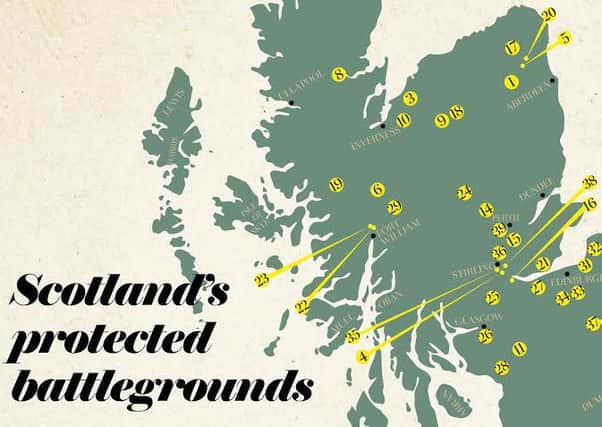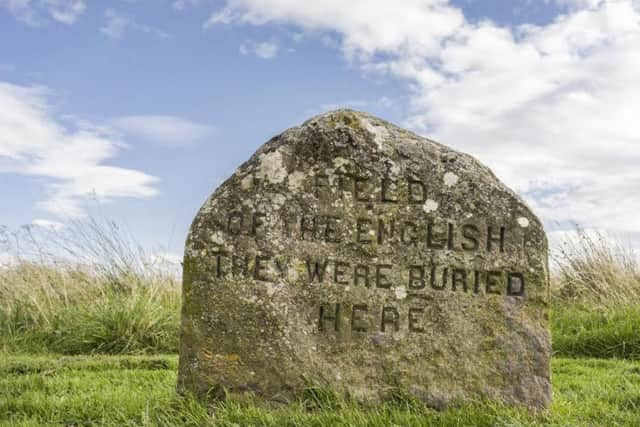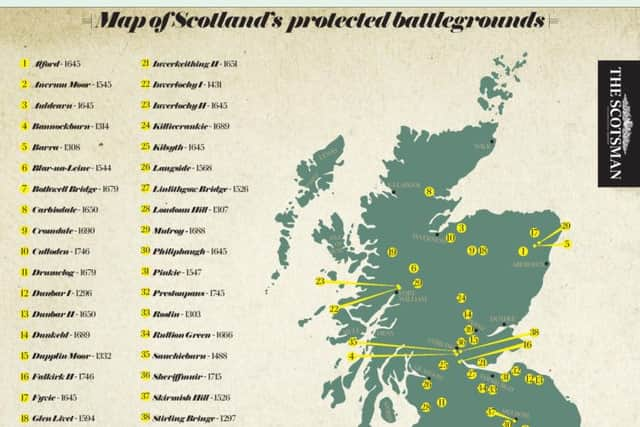Map: Scotland key battle sites throughout the ages


Today, across the country, there are 39 protected battlegrounds which act as a reminder to some of the most violent days in Scottish history.
We’ve mapped out the 39 battles sites protected by Historic Environment Scotland that mark some of the most significant moments in Scottish history.


Advertisement
Hide AdAdvertisement
Hide Ad1. Alford (1645): The Battle of Alford was fought between Scottish Royalists and the Covenanter Government forces during the Wars of the Three Kingdoms. It ended in victory for Montrose and allowed the Royalist army to progress into the lowlands, belittling the power of the Covenanter army.
2. Ancrum Moor (1545): The Battle of Ancrum Moor was part of a campaign by Henry VIII, waged to force Scots to accept the marriage between his son Edward and the infant Mary, Queen of Scots. During their raid on the Borders, the English army was attacked by Scottish forces at the Moor where they were defeated and suffered heavy losses.
3. Auldearn (1645): Auldearn was the first time Marquis of Montrose’s Royalist forces came into contact with an experienced Covenanter army. Despite being outnumbered, Montrose was able to inflict a heavy defeat in what is often thought as his greatest victory.


4. Bannockburn (1314): Bannockburn is one of most famous battles in Scottish history and was a key battle in Scottish Wars of Independence. It gave Robert the Bruce control of Scotland and removed English forces from the country.
5. Barra (1308): The Battle of Barra marked the end of the opposition to King Robert I (the Bruce) in Scotland.
6. Blar-da-Leine (1544): Blar-da-Leine also known as the Battle of the Shirts was fought between rival clans over a dispute in leadership of Clanranald, one of the most powerful branches of Clan Donald. The battle was won by the MacDonalds but the number of dead and injured remains unknown.


7. Bothwell Bridge (1679): The Battle of Bothwell Bridge brought to an end the 1679 Covenanter rebellion - one of the largest of Covenanter uprisings of the 17th century. It marked the final battle between them and their Government opponents.
Advertisement
Hide AdAdvertisement
Hide Ad8. Carbisdale (1650): Carbisdale was the last battle fought by Marquis of Montrose, in support of the Royalist cause. The scenes marked the end of internal struggles within Scotland and led to Montrose being apprehended and executed by the Covenanters.
9. Cromdale (1690): Cromdale was the final battle during the first Jacobite Rising within Scotland and brought the first attempt to restore James VII to an end. The site was also the location for the final major battle within Scotland in 1600s.
10. Culloden (1746): Another of Scotland’s famous battles, Culloden was the last battle of the Jacobite Rising. The battle saw the Jacobites defeated, marking the end of a sixty year struggle.


11. Drumclog (1679): Drumclog was the location of the opening battle of the 1679 Covenanter uprising which resulted in a victory for the Covenanters which largely benefited their cause and gained them more recruits.
12. Dunbar I (1296): Dunbar was the the site of the first major battle in the First Scottish War of Independence. It was won by the English and destroyed the opposition within Scotland to Edward I for a time.
13. Dunbar II (1650): The second battle of Dunbar was one of the largest and bloodiest in Scottish history. It is also regarded as the most influential battle fought during the Wars of the Three Kingdoms with significant military and political consequences.
14. Dunkeld (1689): Fought between Government troops and the Jacobites, Dunkeld was a defining moment in Scottish history. Much of the town was destroyed during the battle, eventually the Jacobites withdrew and were unable to advance through Perth and Stirling.
Advertisement
Hide AdAdvertisement
Hide Ad15. Dupplin Moor (1322): The Battle of Dupplin Moor was the first battle in the Second War of Scottish Independence and ended in a heavy defeat for the Scottish army and left the country effectively leaderless.
16. Falkirk II (1746): Another battle waged during the Jacobite Risings, the second battle of Falkirk was the penultimate challenge in the risings. The Jacobite army was led by Bonnie Prince Charlie and ended up gaining victory.
17. Fycie (1645): Fyvie was another of Montrose’s victories on behalf of the Royalist cause.
18. Glen Livet (1594): The Battle of Glenlivet was an important moment in the struggles between Presbyterians and Catholics within the country. It was the first time in the Highlands that artillery was used on the battlefield.
19. Glenshiel (1719): Glenshiel was the only battle fought during the 1719 Jacobite Rising and saw the use of Spanish support. Field fortifications still remain, which is rare in Scotland.
20. Harlaw (1411): The Battle of Harlaw is known as one of the bloodiest medieval battles in Scotland’s history. It saw both the MacDonald army and the Earl of Mar suffer heavy losses despite being militarily inconclusive.
21. Inverkeithing II (1651): The second battle of Inverkeithing marked the end of the conflict known as the Wars of the Three Kingdoms and brought the country under the control of the Protectorate of Oliver Cromwell.
Advertisement
Hide AdAdvertisement
Hide Ad22. Inverlochy I (1431): The first Battle of Inverlochy was the first in the struggles between the Scottish monarchy and the Lords of the Isles and was the result of years of effort by King James I to take full control of the Highlands.
23. Inverlochy II (1645): The second battle resulted in one of Montrose’s most iconic victories and saw a number of new recruits join his cause.
24. Killiecrankie (1689): The Battle of Killiecrankie was the initial battle in what would become the first Jacobite Rising.
25. Kilsyth (1645): During the Civil Wars, Kilsyth saw Montrose destroy the last of Covenanter army in Scotland in an unusually enclosed landscape. It gave the Royalists short lived military control of the country.
26. Langside (1568): Before Mary, Queen of Scots fled to England where she was imprisoned and killed, the Battle of Langside took place. Opposing Mary’s army was the Earl of Moray who secured victory and ended her attempts to retake the throne.
27. Linlithgow Bridge (1526): The Battle of Linlithgow Bridge was in aid of freeing James V from the control of the Earl of Angus. The attempt was unsuccessful. It would be another two years until James was free.
28. Loudoun Hill (1307): One of the first victories of King Robert I (the Bruce) was taken at Loudoun Hill against the English forces. The win aided the strength of his position in Scotland.
Advertisement
Hide AdAdvertisement
Hide Ad29. Mulroy (1688): Known as the last clan battle, the Battle of Mulroy was followed by a drastic change in the nature of clan life and warfare in the Highlands. Two clans, the MacDonalds of Keppoch and the army of Lachlan Mackintosh, fought against each other with the help of their allies.
30. Philiphaugh (1645): During Montrose’s Royalist campaign, his only defeat took place in Philiphaugh. Philiphaugh marginalised Montrose’s army and signalled the end of his campaign in Scotland.
31. Pinkie (1547): The Battle of Pinkie was another result of Henry VII’s campaign to get Scots to accept the marriage between his son and Mary, Queen of Scots.
32. Prestonpans (1745): The Battle of Prestonpans was the opening battle of the 1745 Jacobite Rising, and resulted in their victory. It left them with control of Scotland and the army effectively destroyed.
33. Roslin (1303): One of the biggest battles of the First Scottish War of Independence was the Battle Roslin. It ended in victory for the Scottish.
34. Rullion Green (1666): Rullion Green was the site of the only battle of the 1666 Covenanter rebellion. The uprising was ended after they were defeated.
35. Sauchieburn (1488): The battle at Sauchieburn was the confrontation between disaffected Scottish nobles who were acting against James III. After meeting in Stirling, the rebels secured a victory which resulted in a new King coming to the throne of Scotland.
Advertisement
Hide AdAdvertisement
Hide Ad36. Sheriffmuir (1715): The Battle of Sheriffmuir took place during the 1715 Jacobite Rising, and involved one of the largest Jacobite armies ever fielded in Scotland.
37. Skirmish Hill (1526): The Skirmish Hill was fought between the Tweed and Darnick Tower almost 500 years ago, Archibald Douglas, Earl of Angus, was challenged by Walter Scott of Buccleuch over the custody of the 14-year-old King James V in July 1526.
38. Stirling Bridge (1297): The Battle of Stirling Bridge is one of the most notorious Scottish battles and victories in the Wars of Independence. The battle led to the appointment of William Wallace as Guardian of the Realm of Scotland.
39. Tippermuir (1644): The Battle of Tippermuir was the first victory for Montrose which saw him take succeed over a much larger and better equiped Covenater army.